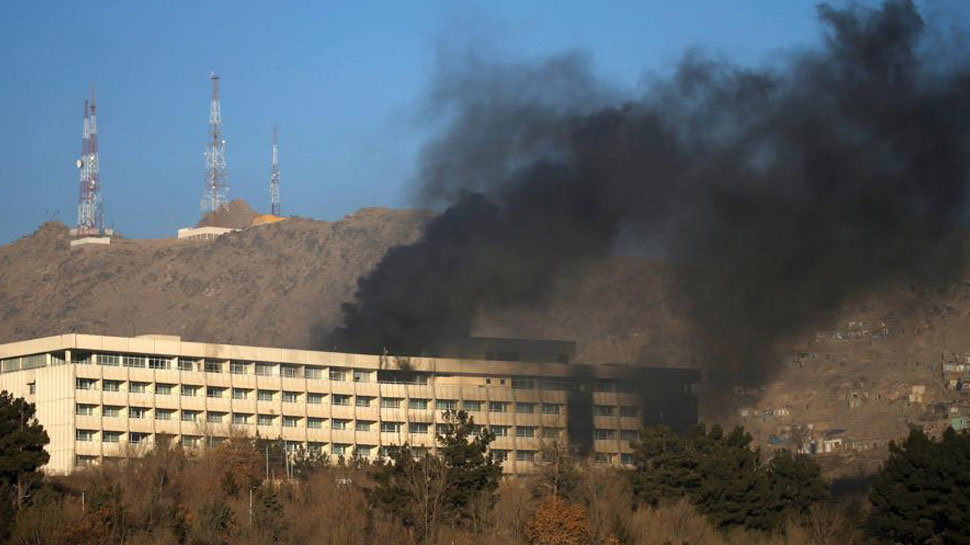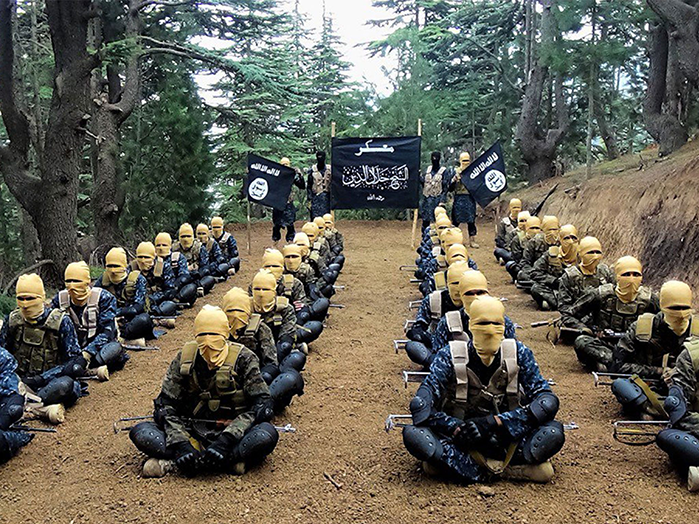Time for the US to Quit Afghanistan
As Taliban gain ground, US can only save face by leaving
Empowering Weak & OppressedZia Sarhadi
Jumada' al-Ula' 15, 1439 2018-02-01
News & Analysis
by Zia Sarhadi (News & Analysis, Crescent International Vol. 46, No. 12, Jumada' al-Ula', 1439)
In addition to Afghanistan, Pakistan has suffered the most from America’s 16-year war in the landlocked country. Pakistan’s human losses — nearly 70,000 dead and $120 billion in infrastructure damage — are colossal by any standard. America’s 2,400 military personnel deaths pale into insignificance compared to Pakistan’s.
It is America’s war launched without reason or cause, unless hubris counts as justification for launching wars in distant lands. But that is precisely what has happened. It was the neocons ensconced in important positions within the regime and in various right-wing think tanks that came up with the ludicrous — and dangerous — notion that America should go for “full spectrum dominance.” Following the demise of the Soviet Union, Washington should not allow the emergence of a rival power to challenge US hegemony, the neocons argued. Further, that the American people would be convinced of this militaristic policy if there were another “Pearl Harbour type attack” on the US mainland.
The 9/11 attacks occurred at such a convenient time that many experts believe it was an inside job. Further, the official inquiry commission has gaping holes in it that simply served the neocons’ nefarious agenda. But here is the rub: the US launched the war on Afghanistan — not Saudi Arabia from where 15 of the 19 alleged hijackers had come. The US accused Osama bin Laden of planning the attacks, a charge he vehemently and repeatedly denied. True, he praised the attackers but that could hardly be used as justification for launching war on a country where he was staying. Washington demanded that the Taliban government hand him over to the US; the Taliban demanded proof of his involvement in the attacks. George Bush and his neocon handlers scoffed at the demand and told the Taliban, “We’ll see you in Kabul.”
The US launched what is now referred to as the longest war in its history. After more than 16 years of war and intense bombing of mud hut villages in Afghanistan, the Washington warlords are nowhere near achieving any of their objectives that not only remain vague but also keep shifting.
At the height of the war, the US-NATO had 160,000 troops in Afghanistan. Of these, 100,000 were American soldiers. According to the best guestimates, the Taliban never had more than 35,000 to 40,000 men under arms. Yet they have given a bloody nose to the self-declared superpower. The reason is simple: unlike the Americans, the Taliban — and Afghans in general — are not afraid of death. Further, they enjoy the support of the Afghan population. This explains why they control or have influence in at least 60% of Afghanistan. The other 40% territory is no man’s land with total lawlessness. The puppet regime installed by the Americans cannot enforce its writ even in Kabul where attacks and explosions are quite frequent. The latest attack occurred on Kabul’s Intercontinental Hotel on January 21. The hotel is not only in a secure area in Kabul but is located on a hilltop. How did the gunmen manage to penetrate such a security cordon with American and Afghan troops everywhere?
American troop levels have declined in recent years. At present they stand at around 13,000 although the Pentagon announced on January 12 that another 1,000 American troops would be deployed this month to “help” the Afghan army fight off the Taliban’s expected spring offensive.
The US has spent nearly $1 trillion in Afghanistan since October 2001. Militarily or economically, it has anything to show for its 16-year campaign. Afghanistan remains virtually at the bottom of the Human Development Index. So what precisely is its mission in Afghanistan? Even Osama bin Laden, the bogeyman for launching the war on Afghanistan, is long dead and gone.
The Taliban have shown that they cannot be defeated militarily. This much should be clear even to the gung-ho American generals. Who are the Taliban and how did they emerge?
Many of them are veterans of the Afghan war against the Soviets. At that time, they were called mujahidin (freedom fighters); today they are branded as “terrorists” because they are no longer useful as America’s Cold Warriors. That 10-year struggle (December 1979 – February 1989) resulted in the defeat of the Red Army and ultimately disintegration of the Soviet Union. Ronald Reagan who was president during most of those years even welcomed a mujahidin delegation to the White House!

Like all wars, the war against the Soviets also caused a massive refugee problem most of which has been borne by neighboring countries, especially Pakistan and Iran. Each has hosted between 3–4 million refugees. They did not return home even after the Soviet withdrawal in February 1989 because a power struggle erupted among former mujahidin allies. The US too abandoned Pakistan to face the consequences of the 10-year Afghan war.
These included a drug culture spawned by opium cultivation in Afghanistan. While former allies struggled for power in Kabul, warlords emerged in the rest of Afghanistan to stake out their own claims. There was no safety or security for people amid such lawlessness. It was affecting Pakistan as well, that still hosted millions of Afghan refugees.
Pakistan took steps to address the problem and helped in the creation of the Taliban. The movement of the madrasah students put an end to the lawlessness ravaging Afghanistan even if their obscurantist views have caused much angst among Muslims elsewhere.
Initially, the Taliban had the blessings of the US and Britain as well. The Americans had no problem dealing with them, even inviting a delegation to visit the US in December 1997. UNOCAL executives facilitated the Taliban’s visit. The American oil company was keen to build a gas/oil pipeline from Turkmenistan through Afghanistan to Pakistan. When the Taliban awarded the contract to the Argentine company BRIDAS, the Americans went ballistic and all hell broke loose. They vowed to teach the Taliban a lesson; the 9/11 attacks were used as pretext to launch the war on Afghanistan.
Already devastated, the landlocked country has since been bombed beyond the Stone Age. Hundreds of thousands of poor Afghans have been murdered and the war is still raging but the US has not succeeded in its nefarious agenda to subdue the intrepid Afghans. True, the Americans have installed their puppets as rulers in Kabul but their writ, like that of the Americans does not extend beyond the capital and even that is not guaranteed.
After 16 years of war and total failure, it is time for all foreign troops to leave Afghanistan. If the Washington warlords will not do so willingly, they should be forced to withdraw.
All of Afghanistan’s neighbors — Iran, the Central Asian Republics, Russia, and China — want US forces to leave. Not one of them was supportive of the US invasion in the first place but after 16 years of bloodletting and destabilization of the region, it is time for Uncle Sam to pack his bags and go home!
Americans are sore losers; they have never won a single war in their entire history notwithstanding the genocidal war on Native Peoples in the Americas. More than 40 million unarmed or lightly armed indigenous peoples were murdered in the Europeans’ colonial drive.

Pakistan should make clear that it would provide transit facilities to US-NATO forces but not to bring more war materiel into Afghanistan. The transit facility would be for exiting US forces out of Afghanistan on their way back to the US.
Washington’s demand that the Taliban should be forced to negotiate with the puppet regime in Kabul is a non-starter. It is for the Afghans to decide, not any outside powers. The Taliban have repeatedly said they will not accept the US-imposed constitution on their country, nor the puppets installed in Kabul.
Once the US-NATO forces exit Afghanistan, the puppet regime would collapse. Ashraf Ghani admitted in the CBS “60-Minutes” program broadcast on January 14 that if American support were withdrawn, the Afghan army would collapse within six months. So much for America’s $1 trillion spent in Afghanistan in 16 years.
In the interim, Islamabad should emphasize that it expects the US and Afghan forces to halt all terrorist attacks against Pakistan from across the border in Afghanistan. These terrorists enjoy safe havens in Afghanistan right under the noses of US and Afghan forces. In addition to Tehrik-e Taliban Pakistan (TTP) and Jamaatul Ahrar, there has been a huge influx of ISIS terrorists into Afghanistan, courtesy of the US.
Zamir Kabulov, Russia’s special envoy for Afghanistan said in November that there were more than 10,000 ISIS terrorists in Afghanistan. This number is likely to increase — and perhaps has already risen — as the terrorists face further defeats in Syria. The US is relocating them to Afghanistan.
The presence of terrorists to the west in Afghanistan, and India’s huge military build-up to the east, pose an existential threat to Pakistan. Islamabad cannot take these threats lightly; it must protect its interests, indeed its very survival.
The Afghans themselves must determine the future of their country. Their neighbors — China, Pakistan, Iran, the Central Asian Republics, Russia, and Turkey but not India — should help them find a solution. It must be Afghan-led and no group should be excluded from it.
America is a destructive power; it has never brought stability anywhere. In recent years, its involvement in Iraq, Libya, and Syria amply demonstrates its disruptive and destructive role. It is a supporter of terrorists. Why should it be assumed that its conduct would yield any different results in Afghanistan?
It is for Afghanistan’s immediate neighbors to take steps to protect their own interests and in the process help the Afghans to achieve peace and stability in their country. This must begin with the immediate exit of all US and NATO forces from Afghanistan. It is long past due.
From Pakistan’s perspective, Washington’s close alliance with Hindu India is meant to disrupt the $50 billion China Pakistan Economic Corridor (CPEC). While the project would connect the region and bring huge prosperity to Pakistan, the evil duo is hell bent on disrupting and, therefore, destroying it. Hindu India is also involved in terrorist activities in Baluchistan. There is ample reason to suspect that the US has given its blessings to such Indian crimes.
With such open US hostility and India’s historical enmity toward Pakistan, the rulers in Islamabad would be derelict if they do not take steps to safeguard the country’s interests.

